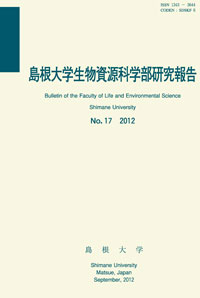島根大学生物資源科学部
ISSN:2435-0885(オンライン)
ISSN:1343-3644(冊子体)
なお、冊子体の刊行は23巻まで
ISSN:1343-3644(冊子体)
なお、冊子体の刊行は23巻まで

ダウンロード数 : ? 件
この文献の参照には次のURLをご利用ください : https://ir.lib.shimane-u.ac.jp/40647
島根大学生物資源科学部研究報告 22
2017-09-30 発行
三瓶演習林の土壌断面の観察
Descriptions of two soil profiles in the Sambe Forest, Shimane University
山下 多聞
島根大学生物資源科学部附属生物資源教育研究センター森林科学部門
橋本 哲
島根大学生物資源科学部農林生産学科
藤巻 玲路
島根大学生物資源科学部農林生産学科
尾崎 嘉信
島根大学生物資源科学部農林生産学科
葛西 絵里香
島根大学生物資源科学部農林生産学科
黒崎 勇登
島根大学生物資源科学部農林生産学科
ファイル
内容記述(抄録等)
We investigated two soil profiles 3-m deep in the Sambe Forest and determined some physico-chemical and biological properties of soils to describe the characteristics of deeper soil layers that were hard to reach. Deeper soil layers are expected to play important roles in the potential ecological services of forest ecosystems. One profile was made at the ridge part of a slope under a secondary forest. Another was made at the lower slope under a cedar plantation. Soil type was Cambisols at the ridge and Andisols at the lower slope. The two soil types are typical ones in the forest. Both soils reserved more than 1000 mm of water within a profile. Organic carbon stored in the soils was 20 kg m^<-2> at the ridge and 39 kg m^<-2> at the lower slope. Fine root was found even at the deepest layer and the biomass of fine roots was 1.3 kg m^<-2> at the ridge and 0.8 kg m^<-2> at the lower slope. Soil water distributed evenly from the top soil to the deepest layer. Soil organic carbon and fine root biomass concentrated mostly to the top soil. Deep soil water might contribute to the stability of stream discharge running through the forest and to water supply for the deep rooting trees during draught.
About This Article
権利関係
島根大学生物資源科学部
Other Article
PP. 13 - 16
